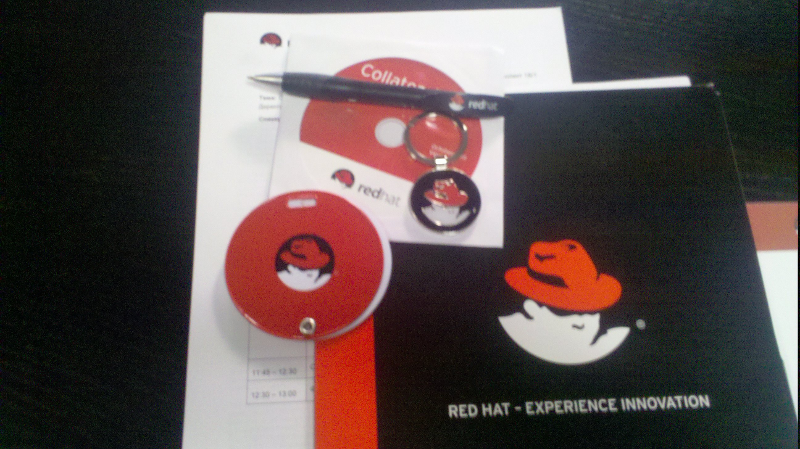Red Hat is now in Russia: “We need to be closer to the client”
 Suddenly I was among those invited to the press conference on the official opening of the Red Hat representative office in Russia. The event took place on October 13 at the Renaissance Moscow Hotel and, apart from the small linings, was organized at a high enough level. Honestly, I thought that the press conference would be boring and prim, but it was wrong. Under Habrkat description of everything that happened at the press conference will be diluted with my comments (italics). I apologize in advance for the quality of the photos - I took pictures on the camera of the phone.
Suddenly I was among those invited to the press conference on the official opening of the Red Hat representative office in Russia. The event took place on October 13 at the Renaissance Moscow Hotel and, apart from the small linings, was organized at a high enough level. Honestly, I thought that the press conference would be boring and prim, but it was wrong. Under Habrkat description of everything that happened at the press conference will be diluted with my comments (italics). I apologize in advance for the quality of the photos - I took pictures on the camera of the phone. Officially, the press conference was titled “Opening a Red Hat Representative Office in Moscow and appointing Sergei Bugrin to the position of Director of Business Development for Red Hat in Russia and the CIS”. First, Werner Knoblich, vice president and general manager of EMEA at Red Hat, spoke with a welcoming speech. He said that it was not the first time in Russia and he was very pleased that the opening of a full-fledged representation of Red Hat coincided with government initiatives to develop open source software. Werner hopes that Red Hat, for its part, will also be able to contribute to the development of Russian open source software companies.
Werner visits Russia almost every year, which is quite common for the Vice-President of Red Hat. For example, on the sidelines said that Knoblich’s trips are scheduled for at least six months in advance, so his visits are not spontaneous visits, but an indicator of a long-standing and active study of the Russian market. By the way, Russia has become the 12th European country where the full-fledged representation of Red Hat is open.
')
Then Sergey Bugrin was introduced - the head of the Russian representation of Red Hat. He said that the expansion of presence in Russia and the CIS is in line with the general corporate strategy of Red Hat. The Red Hat board of directors promised to closely monitor the performance and results of the Russian office. By the way, there is no office yet - Sergey is the only Red Hat employee in Russia, although it is planned to change this situation in the medium term. :-)

Sergey Bugrin tells something (Werner sits at the table on the left).
Later, answering questions, Bugrin said that the official opening of the representation takes place 2 months after the first news appeared in the media, due to the fact that it took time to approve the work plans and all approvals. Well, I think that just some of our journalists are quick and ready to write any
Then Sergey said that despite the fact that the official representation is opening only now, Red Hat products and services in Russia have been available for quite some time. Moreover, there is a fairly strong affiliate network. There are reliable partners and valuable customers. Well, afterwards, it was these very partners and customers who spoke.
Nikolay Egorov, a representative of the MICEX , was invited as one of the clients. He told that since the mid-1990s, the exchange worked on UNIX solutions, but “grew” out of them a couple of years ago and performance problems began to show up. Following the recommendations of Western colleagues, it was decided to migrate from UNIX to RHEL. Preparations for the full migration took about two years. During this time, the results were obtained "radically different" from what they had "before." Nikolay noted that the presence of one expandable platform, combining both the convenience of work and performance, was a decisive factor in making the decision on migration.
Not surprisingly, MICEX was invited as a client. The financial sector is one of the most important areas for Red Hat. Almost all of the large, global stock exchanges work on Red Hat solutions, and besides, products are popular in the banking sector. After all, low cost and stable operation are extremely important for financial market companies. A reasonable price (relative to UNIX) and reliability are key Red Hat benefits.
As a partner from Russian companies, Arkady Tagiyev from NCPR was invited. This company is the master distributor of Red Hat and, among other things, assembles the MSVSfera distribution kit — the version of RHEL that is specially adapted to the Russian security requirements.
Everyone probably heard about the MSVS from VNIINS - the first Linux, widely used in the public sector. This is from the same series, but a product that was created with Red Hat, and not “assembled on the knee”. Simply put, this is for those who want to use RHEL for processing personal data and other applications required by the competent authorities.

Handouts nishtyaki - pen, keychain, dad with pieces of paper and CD.
As another important partner in the Russian market, Denis Sosnovtsev was invited - a well-known among Linux users, a man. He headed the Linux Competence Center at IBM in the early 2000s. Denis said that Red Hat is an old, reliable partner of IBM around the world and that in Russia they have also been cooperating for a long time and productively. The upcoming common initiatives include collaboration in the field of cloud computing, working in the consortium of the Open Virtualization Alliance and promoting KVM.
By the way, I just recently wrote about the Open Virtualization Alliance . It is clear why Denis Sosnovtsev was invited - Bugrin himself worked until recently in IBM and a partnership with an IBM-level corporation simply needs Red Hat if they do not want to lose in the “ war against VMware ”.
Then again the word passed to Werner and he told something about the company's strategy - now it relies on three products. The first is RHEL, which has a stable demand, the second is JBoss middleware, whose sales are growing very actively after the events around OpenJDK, Java and Oracle. And the third is RHEV and cloud computing, for which Red Hat has high hopes ( I also wrote about this ). All these products are interrelated and form a solid foundation for harmonious growth. Werner said that Red Hat has very good global earnings figures (something about an increase of 30% over the last quarter), while other companies' revenues are falling.
When Red Hat employees were asked about specific sales figures in Russia, they avoided answering, explaining that it’s better to take the figures from official reports (and they were printed and invested in daddy for everyone), because even the best results can be misinterpreted, which will affect the stock price. It is curious that over the past few months (not constantly following), the capitalization of Red Hat has grown by almost 10% - it seems to me, not very bad.

Werner Knoblich, after the end of the press conference.
In addition, Werner paid great attention to cloud computing. He said that virtualization should be cheap ( I wrote about that too ). I also said that today cloud computing is built primarily on open source precisely because of the lack of large investments in software. Both the IBM public cloud and the recent purchase of Gluster have been mentioned.
It is indicative that the roll-up advertising Red Hat cloud solutions was put on the most prominent place - behind the speakers (there were two more, but they were in the corners). I think that the bet on cloud computing was not made in vain, because Red Hat gets most of the profits from companies that want to leave vendor lock-in, and there will soon be a lot of them on the cloud market . ;-)
Among the main priorities of the company, Werner named the following: “Do not forget where Red Hat came from,” “Give the user a choice,” “Do not leave customers one-on-one with their problems.” Knoblich said that up to 90% of funds earned in a given region remain in it and are directed to the development of the local market - to partners (Red Hat gets about 60% of sales through the partner network), invested in local development centers, etc. . Nearly 90% of buyers return to renew subscriptions and / or buy new products.
As a general impression: Thus, Red Hat does not come “to the open field”, there is already an existing system in Russia - the products are localized and certified, there are both technological and business partners. And among the main tasks of the Russian office are such as “being closer to the client” and “supporting our partners in complex projects”.
ps: Red Hat links open in Russia Red Hat opens representative office in Russia Red Hat representative office opens in Moscow
Source: https://habr.com/ru/post/130650/
All Articles